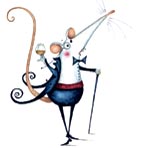Town mouse visits Leighton House
Town mouse admires the beautiful paintings hung in Leighton House.

It's always a delight to visit Leighton House, the studio house in Holland Park, W14, created for Frederic Lord Leighton, regarded by his contemporaries as another Michelangelo. Victorians knew they ought to honour genius, yet found the tools of critical judgment lacking. Artists exploited this uncertainty by insisting that they were taken at their own valuation: studio houses generally went up at the beginning of an artist’s career, as an advertising prospect, rather than at the end, as a reward for financial success. Leighton’s, with its Arab Hall modelled on a palace in Palermo, was dazzling.
Now, it’s filled with paintings either by Leighton or his contemporaries, loaned from the astonishing Pérez Simón collection in Mexico. The culmination is Alma-Tadema’s The Roses of Heliogabalus, showing guests at an imperial banquet being smothered (literally) with rose petals. Sublimely, the scent of roses has been diffused throughout the gallery, courtesy of Jo Malone. Photographs owned by Alma- Tadema show the care he took to get archaeological details right. Leighton’s Crenaia, the Nymph of the Dargle, painted for Lord Powerscourt through whose estate the River Dargle runs, shows Leighton’s model and mistress, Dorothy Dene, a south London girl whom he backed to be an actress. She’s supposed to have been the inspiration for Eliza Doolittle in George Bernard Shaw’s Pygmalion.
Town mouse remembers the First World War
Town mouse discovers a brilliant new blog.

Town mouse dines at the London Library
Town mouse attends the London Library's literary dinner.

Town mouse considers the resurgence of facial hair
Town mouse considers one of the few male fashion accessories that's guranteed to be noticed: facial hair.

Town mouse visits the Edward Lear Society
Town mouse remembers Edward Lear.
Sign up for the Country Life Newsletter
Exquisite houses, the beauty of Nature, and how to get the most from your life, straight to your inbox.
-
 About time: The fastest and slowest moving housing markets revealed
About time: The fastest and slowest moving housing markets revealedNew research by Zoopla has shown where it's easy to sell and where it will take quite a while to find a buyer.
By Annabel Dixon
-
 Betty is the first dog to scale all of Scotland’s hundreds of mountains and hills
Betty is the first dog to scale all of Scotland’s hundreds of mountains and hillsFewer than 100 people have ever completed Betty's ‘full house’ of Scottish summits — and she was fuelled by more than 800 hard boiled eggs.
By Annunciata Elwes